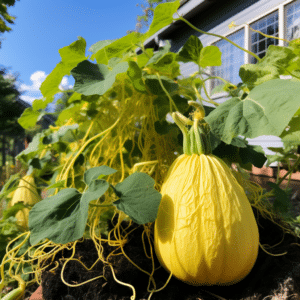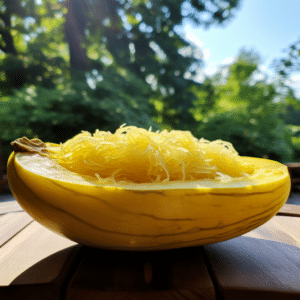Spaghetti squash, with its unique texture and mild flavor, is a versatile and nutritious addition to any garden. Whether you’re a seasoned gardener or a beginner, growing spaghetti squash can be a rewarding experience. This guide will provide you with comprehensive information on how to grow, care for, and harvest spaghetti squash successfully.
The Basics of Spaghetti Squash

Spaghetti squash, also known as vegetable spaghetti, is a type of winter squash. It is named for its unique flesh, which when cooked, separates into long, thin strands resembling spaghetti. This squash is not only delicious but also packed with nutrients like vitamin A, potassium, and fiber.
Spaghetti squash plants are typically grown from seeds and can thrive in a variety of climates, although they prefer warm, sunny conditions. They are hardy plants that can resist most pests and diseases, making them an excellent choice for organic gardening.
Choosing the Right Variety
There are several varieties of spaghetti squash available, each with its own unique characteristics. Some popular varieties include ‘Small Wonder’, ‘Orangetti’, and ‘Vegetable Spaghetti’. ‘Small Wonder’ is a compact variety that is ideal for small gardens or containers. ‘Orangetti’ produces orange-fleshed fruits that are sweet and flavorful. ‘Vegetable Spaghetti’, the most common variety, produces large, yellow fruits.
When choosing a variety, consider your garden space, climate, and personal taste. All varieties of spaghetti squash have similar growing requirements, so choose the one that most appeals to you.
Planting Spaghetti Squash

Spaghetti squash seeds should be planted in the spring, after the danger of frost has passed. They require a long growing season and warm soil to germinate and grow properly.
Before planting, prepare the soil by adding compost or a slow-release fertilizer. This will provide the nutrients the plants need to grow strong and healthy. Plant the seeds about an inch deep, spacing them about 3 feet apart. Water thoroughly after planting.
Starting Seeds Indoors
If you live in a region with a short growing season, you can start your spaghetti squash seeds indoors. Start them about 4-6 weeks before the last expected frost date. Plant the seeds in biodegradable pots, as squash plants do not like their roots disturbed. Once the danger of frost has passed, you can transplant the seedlings outdoors, pot and all.
Keep the seedlings in a warm, sunny location and water regularly. Once they have developed their first true leaves, you can begin to harden them off by gradually exposing them to outdoor conditions.
Caring for Spaghetti Squash Plants
Spaghetti squash plants require regular care to produce a good harvest. This includes watering, fertilizing, and pest control.
Water the plants deeply and regularly, especially during dry periods. Squash plants have large leaves that can lose a lot of water through evaporation, so they need a consistent supply of water. However, avoid watering the leaves as this can lead to fungal diseases.
Fertilizing and Pruning
Feed your spaghetti squash plants with a balanced fertilizer every 4-6 weeks during the growing season. This will provide the nutrients they need to produce large, healthy fruits.
Pruning is not usually necessary for spaghetti squash plants. However, if the plants become too large or unruly, you can prune them back to keep them in check. Just be careful not to remove too many leaves, as this can reduce the plant’s ability to photosynthesize and produce fruits.
Pest and Disease Control
While spaghetti squash plants are generally resistant to pests and diseases, they can sometimes be affected by common garden pests like squash bugs and cucumber beetles. Check your plants regularly for signs of these pests and remove them by hand if necessary.
If your plants show signs of disease, such as wilting or yellowing leaves, it may be due to a fungal infection. In this case, remove the affected parts of the plant and treat with a fungicide if necessary.
Harvesting and Storing Spaghetti Squash

Spaghetti squash is ready to harvest when the skin is hard and cannot be easily pierced with a fingernail. The color should be a deep, solid color, and the stem should be dry and brown.
Use a sharp knife to cut the squash from the vine, leaving a few inches of stem attached. This will help the squash store longer. After harvesting, let the squash cure in the sun for a few days to harden the skin and improve the flavor.
Storing Spaghetti Squash
Spaghetti squash can be stored for several months in a cool, dry place. Check the squash regularly and use any that start to soften or show signs of decay.
Spaghetti squash can also be cooked and frozen for later use. Simply cook the squash, remove the strands with a fork, and freeze in airtight containers.
Using Spaghetti Squash
Spaghetti squash is a versatile vegetable that can be used in a variety of dishes. It can be baked, boiled, steamed, or microwaved, and the strands can be used as a low-carb substitute for pasta.
Try mixing the cooked strands with your favorite pasta sauce, or use them in a stir-fry or casserole. The possibilities are endless!
With its unique texture and mild flavor, spaghetti squash is a wonderful addition to any garden. By following these tips, you can enjoy a successful harvest of this versatile and nutritious vegetable.
